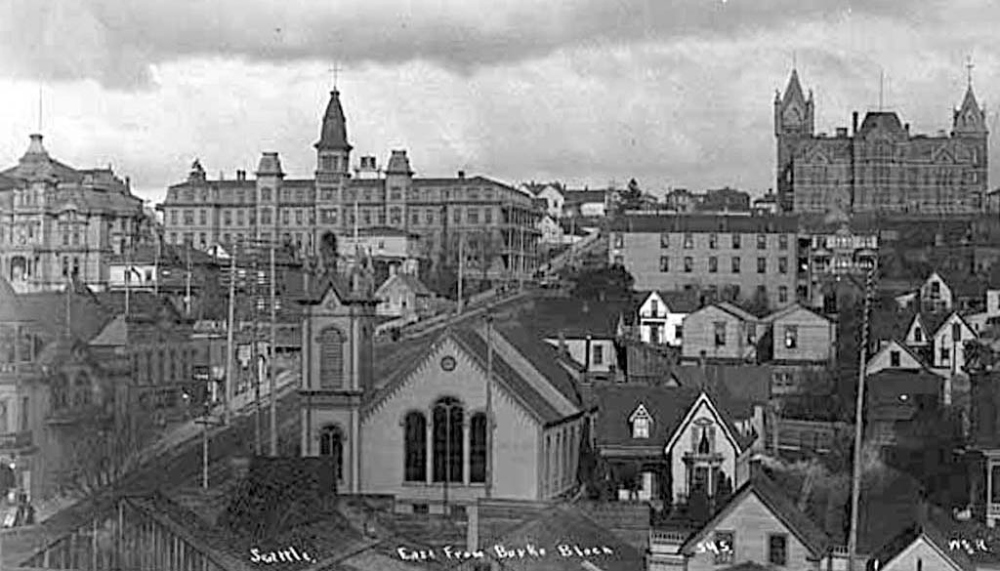February was Black History Month. I was curious to see how and where a “celebration” of that month would occur, so I visited a couple of sites (including my alma mater, Seattle’s Garfield High School), grazed newsprint and electronic news sources, and discussed the issue with friends and family. Except for patches of activities – especially in and near the revised and now-apartment-rich neighborhood at 23rd Avenue and Union Street, and a few newspaper and TV editorials — Black History was not prominent.
Raised in Seattle’s Central Area, I shared friends of all racial, religious and national backgrounds. My local neighborhood history, The Last Electric Trolley, published in 2000, saluted historian Quintard Taylor’s The Forging of a Black Community: Seattle’s Central District from 1870 Through the Civil Rights Era. It also described William Grose, a Black pioneer, who “first worked in California and British Columbia where he assisted Black people settle.” Grose’s accommodating activities were enhanced by his opening of Our House, one of Seattle’s earliest restaurants.
After losing his business in the 1889 fire, Grose “retired” to his 12-acre farm between 24th and 27th Avenues and Howell and Olive Streets – the seedbed of today’s “Central District.” With the 1889 extension of the Madison Street cable car line, Seattleites easily moved between downtown and Lake Washington, through the alleys and dirt roads of William Grose’s burgeoning neighborhood.
Black pioneers moved to Seattle – like many other groups – to work in shipping, railroading, and for those seeking gold in Alaska and Canada. Living in the Pacific Northwest was not a smooth experience for Blacks. During World War I they were denied service at restaurants and other accommodations. As their numbers increased, they encountered racial discrimination in high gear.
When the Washington State Federation of Women’s Clubs reaffirmed its ban on Black members, the result was a rise in the number of black women’s social and civic organizations. Over time, those groups provided leadership, political strength, and a haven for black culture and history. Jackson Street, on the edge of the Central District, later erupted and shook with some of America’s most innovative black jazz performers, including Seattle’s Quincy Jones.
Racial discrimination lingered. For example, the Skinner family’s Alaska Steamship Company at first employed Blacks only as cooks and scullery men; later Swedish and Japanese immigrants eventually replaced Blacks as domestics. Historian Richard C. Berner notes that Harry Chadwick, editor of the Argus, Seattle’s weekly newspaper for the local business elite, complained about putting Black prizefighters in the same ring with whites. Chadwick also railed against racial intermarriage. Alexander Pantages, a Greek immigrant who had himself experienced severe discrimination, confined Black customers to the balconies of his theaters.
By the 1890s, two African American churches were established — Mount Zion and the Jones Street African American Episcopal Church (AME). In turn, those organizations sponsored auxiliary activities for literary, social, educational, and political projects. One of those events (1891) was a community-wide picnic on the shores of Lake Washington’s Madrona Park. The picnic event continued for 40 years, into the 1930s.
Going wherever work was available, many Blacks took menial work or opened their own businesses. It was common practice in these decades to pay a Black less than a white co-worker. Pushed too far in the 1920s, Black dockworkers struck for union scale and won in Tacoma and Seattle. Many employers, with no remorse, replaced Black workers with Japanese and Filipinos.
By the 1930s the NAACP had stopped discrimination in many public places, including at several lake resorts and the Seattle Ice Arena. Four local radio stations agreed to eliminate “disagreeable” terms used to identify Blacks.
The road to equality and fair employment has been, and remains, full of potholes. Perhaps the thin veneer of a “celebration” of Black History Month comes through cultural, social, and educational efforts, abetted by families who set good examples on the home front. We need to take Black History Month more seriously.
Discover more from Post Alley
Subscribe to get the latest posts sent to your email.

What a beautiful article on Seattle Earlier decades. Thank you for Writing it Mr.Rochester.
Racism was waning but still problem in 1969 when we moved to 35th Avenue and Cherry. Three banks refused to give us a loan. There were three black families on our block and the banks feared a trend. A fourth bank allowed us to move into the integrated community and before long we had 35 children in a two block strip. Kick baseball, touch football, and hide and seek invited all comers and neighborhood block parties very August assisted the grown-ups in maintaining a sense of community.
Thanks for the article.
I live in Madrona and formerly had an office on Jackson and First. I walked to work if it wasn’t a downpour, otherwise I took the #2 bus and still had to walk. So, for the uninformed, I walked through the multi-cultural parts of Seattle to the wilder parts of Seattle. I always felt comfortable and enjoyed my walk to work (3 miles). My friends in other parts of the city thought me foolish and risking my life. (We are white’ish ).
I could not understand the fear that my friends projected by my walking to work. I believe that there is no better remedy to fear than exposure. Seeing normal human beings, getting up in the morning, saying hello, commenting on the day, watering their lawn, walking their dog,..is a balm to anxiety.
Pioneer Square required a little more understanding of psychosis and schizophrenia, but most were harmless.
I think we live in enclaves and are anxious. I fear that i took a tangent away from Black History and talked about White History.
The CD and the surrounding districts are a treasure. City life, hurrah!